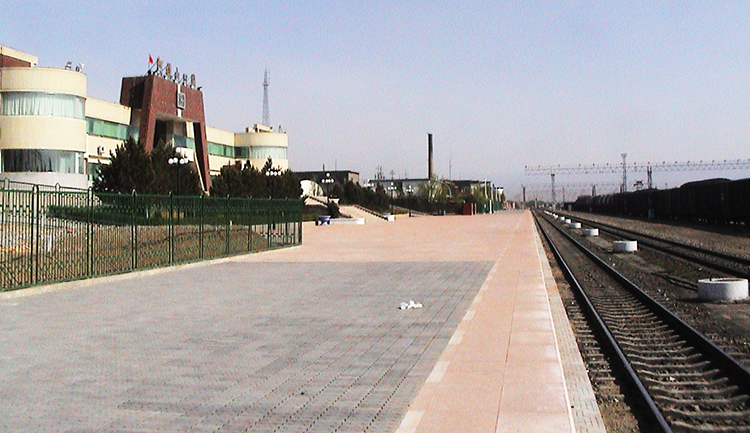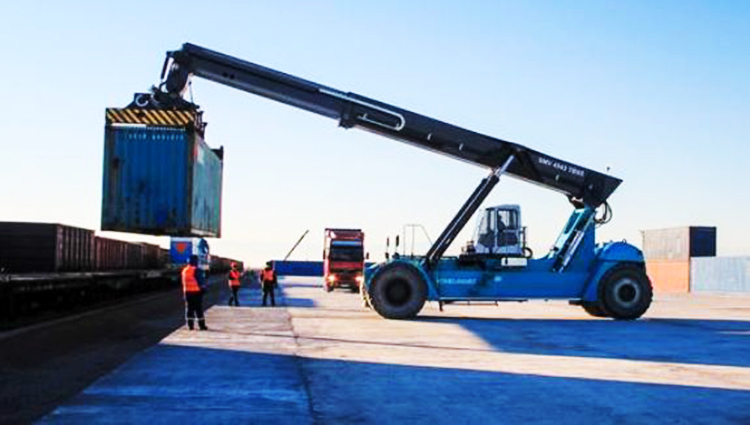Written by: China Economy.cn
Posted on: December 09, 2015 | 
Alashankou railway station
On December 29, 2012, Alashankou became a county-level city in Xinjiang. This youngest city of China was formerly the Alataw Pass – the bridgehead for China’s opening to the West. Last year, the total volume of freight imports and exports of Alashankou railway station reached 16.586 million tons, including 6.044 million tons of exports, up 8.1% from the previous year, which further enhanced Alashankou’s status as the biggest land port of China.
A city built on the same old port, Alashankou has entered the new era of local development. Starting on a high policy level to open to the west and endowed with specially designed policies, the Kashgar and Khorgos Economic Development Zones are gradually becoming the important pivot that facilitate Xinjiang in opening to the West.

As a city of great significance on the ancient Silk Road, Kashgar is the geographic vantage point that “connects eight countries with its five ports and threads Europe and Asia all the way down.” Statistics show that in 2012, the number of passengers on departure flights of Kashgar Airport has, for the first time, reached one million. On January 8, 2013, the 1st Regional International Business, Trade, and Logistics Industries Forum Summit was held in the city. Attendees held detailed talks on the subject and discussed strategies of developing Kashgar and enforcing the core status of the central and South Asian economic circles as part of a joint effort. The forum has also made preparations for the next Kashgar and Guangzhou Trading Fair that will be held in China in 2013.
Meanwhile, Khorgos has also been manifesting its great driving force. The year 2011 witnessed a total volume of 10.50 million tons and a total import and export trade volume of 7 billion US dollars. In 2012, these numbers turned into 13 million tons and 8 billion US dollars respectively. One week before Alashankou was established as a county-level city, Khorgos Railway Pass and Station went into service and the trains of China and Kazakhstan formed a new international railway line. Experts noticed that with the opening of this new international railway route, Khorgos Pass will not only connect China with Central Asia and Europe, but will also become an international transportation hub of the highway, railway, and pipeline networks, promoting business and trade relations between Xinjiang and its neighboring countries. With the adoption of the opening-to-the-West policy, the foreign trade development of Xinjiang is improving exponentially. Statistics show that it only took 10 years for the Autonomous Region to grow its annual export volume from 1 billion US dollars to 5 billion, three years from 5 billion to 10 billion, and just 14 months from 10 billion to 20 billion.
Today, many Central Asian and Eurasian countries are attaching more and more importance to the strategy of opening to the East. This consequently provides Xinjiang with new opportunities for opening its market to the West, attracting investment, and expanding its exports. It is estimated that in 2012, Xinjiang’s total import and export volume would see an increase of 7.7%, above China’s average (in fact, according to the newest official statistics, the growth rate is 10.3%).

The Plans for Building the Economic Development Zones in Kashgar and Khorgos issued by the State Council have promised these two places with a series of favorable policies with regards to finance, taxation, land resources, and human resources. This is followed by the provincial-level authorization of approval and administration endowed by the autonomous region. Recently, four government divisions, including the People’s Bank of China Urumqi Central Sub-Branch and Xinjiang Banking Regulatory Commission, have all proposed that each bank increase its loans to Kashgar and Khorgos, subject to the provisions that the increase should be no less than that of the previous year, the increasing ratio should be no lower than Xinjiang’s average level, all banks should enhance their credit support for infrastructure construction, the development of key industries, and people’s welfare and livelihood, and that banks should issue interim credits when the funds raised by the supporting provinces are still en-route.
A communication network that extends in all directions is the basic condition for Xinjiang’s opening to the West policy. The 4th Full-Committee Meeting of the 8th CPC Xinjiang Uyghur Autonomous Region Conference held earlier this year has made it clear that it is the region’s priority to build a full communication network that leads in all directions, and to have highways on major routes. According to the figures, in 2010, Xinjiang invested 15 billion Yuan in communications infrastructure construction, and the figure soared to 35 billion in 2011, while staying the same in 2012.
Another key measure that Xinjiang has undertaken to strengthen its scale of opening to the West focuses on promoting the convention and exhibition economy. Opportunities such as the China-Eurasia Expo and the Kashgar Xinjiang Central-Southern Asia Trade Fair accelerate the economic relationship between Xinjiang and its neighboring countries. Hu Xiaodong, Vice Director of Xinjiang Bureau of International Expo Affairs told us that the 3rd China-Eurasia Expo will be held in September this year in Urumqi with the theme ‘Open to each other on mutual trust, develop together on mutual understanding’, and so far, 18 international co-organizers have signed in, pushing further the internationalization of the event.
You may also like: